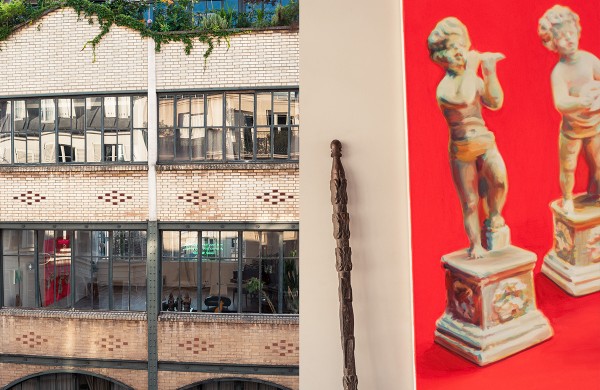About
the project

Nathalie Miltat ouvre depuis deux ans son living room à tous les passionnés d’art contemporain en quête de découverte. Niché au cœur du frémissant 10ème arrondissement de Paris, dans un bâtiment de style Eiffel, anciennement Lithographie Parisienne, APPARTEMENT présente chaque année une saison d’expositions conçue par un commissaire artistique invité. Les artistes sont invités à concevoir des propositions en dialogue avec la collection de la maîtresse des lieux et les ambiances singulières de son living room.
À la fois galerie d’art, lieu de rencontre, de performance, de contemplation et de dialogue, APPARTEMENT s’est imposé avec brio parmi ces nouvelles places parisiennes qui renouvellent le rapport à l’art.

La Lithographie Parisienne a été créée en mars 1866. Elle doit sa naissance à la grève qui oppose durant l’été 1865 plusieurs centaines d’ouvriers imprimeurs lithographes parisiens à leurs patrons. À l’issue de sept semaines de conflit, 30 grévistes décident de se passer de patron.
L’année suivante, ces 30 grévistes fondent leur propre entreprise, Guillaumin, Schmit et Cie. Faute d’expérience commerciale, l’entreprise fait faillite en 1870, mais redémarre peu après. Elle se dote de matériel moderne à vapeur au lieu des anciennes presses à bras, déménage au 27 bis rue Corbeau, et décroche une médaille d’argent à l’exposition universelle de 1878. L’entreprise fait face
à une deuxième faillite en 1884 mais M. Romanet parvient à la relancer.
Après ces deux faillites, la Lithographie Parisienne fait preuve d’une exceptionnelle longévité, et, pendant des décennies, les ouvriers rouges impriment à tour de bras des images pieuses, des chromos éducatifs, des calendriers, des publicités pour le chocolat Louit, le tapioca de l’Etoile, le Bon Marché ou La Samaritaine.
En fonctionnement jusque dans les années 1990 l’imprimerie de la rue Corbeau, devenue en 1946 rue Jacques-Louvel-Tessier, a aujourd’hui disparu. La façade de fer et de briques qui date de 1923 est cependant restée intacte, avec ses inscriptions.
Acquise en 1996 par un collectif de réalisateurs et d’architectes, la Lithographie Parisienne poursuit sa destinée au coeur du foisonnant dixième arrondissement. Avec APPARTEMENT, Nathalie Miltat lui offre une nouvelle grande date de son histoire.


For two years now, Nathalie Miltat has opened her loft to all enthusiasts of contemporary art looking for something new.APPARTEMENT is the name of her gallery in the heart of Paris’s exciting 10th arrondisement. It is in an Eiffel style building that was formerly a printing works called La Lithographie Parisienne. Each year, a curator is invited to design a season of exhibitions, with artists encouraged to present works that enter into dialogue with the owner of the space’s own collection and with the unique atmosphere of her living room.
APPARTEMENT, which is both art gallery and meeting place, as well as a place for performance, for contemplation and for dialogue, has established itself triumphantly as one of the new Parisian spaces that offer a fresh approach to art.

La Lithographie Parisienne came into being in March 1866. It owed its origin to a strike during the summer of 1865, which brought several hundred Parisian lithography printers into conflict with their employers. After seven weeks of confrontation, thirty of the strikers decided they could do without an employer.
The following year, the thirty strikers started their own business, Guillaumin, Schmit, who & Cie. They lacked commercial experience and the firm went bankrupt in 1870, but they started up again shortly afterwards. They invested in modern steam-driven machines to replace the old hand-operated presses and moved to 27 bis Rue Corbeau. In 1878 they were awarded a silver medal at the Exposition Universelle. Although the firm went bankrupt again in 1884, the lithographer’s managed to relaunch it, this time under the leadership of M. Romanet.
After these two bankruptcies, La Lithographie Parisienne proved exceptionally long-lived and for decades these Communist printers devoted themselves to churning out holy pictures, educational wallcharts, calendars, and advertisements for Louit, a chocolate brand, Étoile tapioca, and department stores Le Bon Marché and La Samaritaine.
The printing press in the Rue Corbeau, which changed its name to rue Jacques-Louvel-Tessier in 1946, was fully functional until the 1990s but it has since disappeared. The iron and brick façade dating from 1923 remains intact however, along with its Art Nouveau inscriptions.
In 1996, a collective of filmmakers and architects acquired La Lithographie Parisienne. It continues life in the pulsating environment of the 10th arrondissement. With APPARTEMENT, Nathalie Miltat has launched a new episode in the history of the building.
